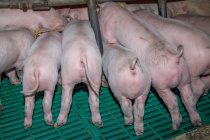Role of nutrition and pig genotype in reducing post-weaning diarrhea
Reduction of post-weaning diarrhea (PWD) caused by enterotoxigenic E. coli (ETEC) is a principal objective in pig farming in terms of welfare benefits. Since therapeutic levels of zinc oxide cannot be used anymore for treating PWD within the European Union, functional feed additives, ingredients and feeding strategies have become fundamental in reducing antimicrobials to sustain the health status and reduce the risk of pathologies. The role of feeding strategies with the addition of functional feed additives has been more and more established. In some farms, although animals are receiving diets that can be regarded as safe from a nutritional point of view, diarrhea can still occur as a problem. It is well known that pathogenic E. coli should first adhere with its’ fimbriae to specific host receptors on the brush border of enterocytes in the small intestine, before production of endotoxins can occur that causes diarrhoea. In a recent study conducted by Anouschka Middelkoop at the research facility of SFR the interaction between feeding strategies and the presence or absence of E. coli receptors in the small intestine of weaned piglets was evaluated. This was done by evaluating the presence of SNP2 as genetic marker from DNA in piglet blood.

A total of 50 piglets, 25 piglets tested positive for E. coli receptors (SNP2+) and 25 piglets tested negative for E. coli receptors (SNP2-), were weaned at 30 days of age and equally distributed to different feeding treatments. On day 10 post-weaning, all piglets were infected with F4-enterotoxigenic E. coli by oral administration. Fresh faecal samples were collected from individual pigs during day 0 and day 22 post-weaning.
The faecal consistency of the samples was determined on an 8-point scale from severe water thin diarrhoea to hard, dry and lumpy faeces. A faecal score of ≤4 was considered diarrhoea, while a faecal score of ≤4 in combination with F4-ETEC detected in the faecal sample on the same day was considered F4-ETEC diarrhoea. Besides measuring diarrhoea, the excretion of the faecal F4-ETEC using quantitative PCR (qPCR) was measured.
Results of the trial showed that the level of faecal F4-ETEC shedding and the percentage of pigs that developed F4-ETEC diarrhoea (72 vs 32%, P < 0.01) following infection were higher, and the duration of F4-ETEC diarrhoea longer (2.6 vs. 0.6 days, P < 0.001), in SNP2+ piglets than in SNP2- piglets. This also led to a lower growth performance in SNP2+ piglets (P = 0.03).
Based on the results of the present study it can be concluded that piglets that have E. coli receptors in the small intestine have a higher risk of developing diarrhea and excrete higher quantities of E. coli compared to piglets that are lacking the intestinal receptors. Interestingly, the feeding strategies that were tested reduced the level and duration of F4-ETEC shedding in both SNP2+ as well as SNP2- piglets. The results of this study support the interest to combine genetics and animal nutrition to reduce the E. coli infection pressure in the barn, which may also reduce secondary and/or coinfections, such as by Streptococcus sui